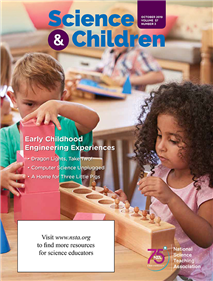All Preservice Science Education resources
NSTA Press Book
Human Impacts on Our Climate, Grade 6: STEM Road Map for Middle School
New in 2020!What if you could challenge your sixth graders to come up with a way to help tackle climate change in their own community? With this volume in the STEM Road Map Curriculum Series, you can! Human Impacts on Our Climate outlines a journe...
NSTA Press Book
The NSTA Atlas of the Three Dimensions
New in 2020! Download and read a sample chapter from this book to learn more.A key aspect of learning in K–12 education is the idea that what students know and are able to do grows and evolves over time. Simple ideas learned in the early elementary...
By Ted Willard
NSTA Press Book
STEM, Standards, and Strategies for High-Quality Units
New in 2020!Download and read a sample chapter from this book to learn more.Do you, your school, or your school district want to align your science curriculum with state standards while meeting the growing demand for STEM instruction? If so, this is ...
By Rodger Bybee
Journal Article
Course-Based Research in the First Semester of College
Undergraduate students are increasingly aware of complex global challenges and have a strong desire to take action and create change. Course-based undergraduate research experiences can offer a wide range of students the opportunity to gain skills ...
By Christina Cianfrani and Sarah Hews
Journal Article
Constructive Error Climate: A Classroom Assessment Technique in Science Classes
Although making errors in the learning process is common, it is usually perceived by students as something negative and a potential threat to self-esteem. Such perception often prevents students from considering errors as learning opportunities. By...
By Yunteng He
Journal Article
Outcomes for Peer-Based Mentors in a University-Wide STEM Persistence Program: A Three-Year Analysis
While the majority of STEM persistence has focused on outcomes for first-year students, there has been little investigation into the outcomes for peer mentors. Of the studies conducted, results are promising. Benefits for peer mentors include a cha...
By Dean T. Spaulding, Jelane A. Kennedy, Amanda Rozsavolgyi, and Wilfredo Colón
Blog Post
Journal Article
Atmospheric Scientist Shawn Urbanski
Atmospheric scientists study the chemical composition of the atmosphere. More specifically, they look at how atmospheric gases, liquids, and solids interact both with each other and with the earth’s surface. This helps people understand such phenom...
By Luba Vangelova
NSTA Press Book
It's Still Debatable! Using Socioscientific Issues to Develop Scientific Literacy, K–5
It’s Still Debatable! encourages scientific literacy by showing you how to teach the content and thinking skills K–5 students need to explore real-world questions like these: • Is football too dangerous for kids? • Do we need zoos? �...
By Sami Kahn
Journal Article
This column enhances the repertoire of preservice and inservice teachers. ...
By Lauren Burrow and Chrissy Cross
Blog Post
Arguing From Evidence to Discover the ‘Why’
In my science classroom, students look at evidence all the time. Sometimes it is in photos or videos; sometimes in charts and graphs; and sometimes we generate our own data through investigations. A more traditional approach previously used is asking...
By Rebecca Schumacher
NSTA Press Book
Radioactivity, Grade 11: STEM Road Map for High School
What if you could challenge your 11th graders to figure out the best response to a partial meltdown at a nuclear reactor in fictional Gammatown, USA? With this volume in the STEM Road Map Curriculum Series, you can! Radioactivity outlines a journe...
NSTA Press Book
Supporting Emergent Multilingual Learners in Science, Grades 7–12
Many middle and high school teachers are educated to teach science content—they don’t anticipate that one day they may be teaching it to students who need to learn both content and English. If the day has come when you’re facing that two-pronge...
By Molly Weinburgh, Cecilia Silva, Kathy Horak Smith





